Part 1 – Overview of Runes we are Studying and Why
Understanding Our Study of the Runes
We have tried to introduce the reader to different factors that have played a part in the development of Runic Exercises. We have briefly looked at the Gnostic-Anthropological aspect, then the Mythological as well as the Historical Background and Context that contributed to the popularity of the Runes. However, our real aim is to study and understand the Gnostic Esoteric aspect of these practices.
As we mentioned at the beginning of the course, our goal has been to prepare the reader for the teachings of Arnoldo Krumm-Heller (Huiracocha) and Samael Aun Weor. Why? Because of the following statement:
“THE CHRISTMAS MESSAGE 1968-69 CONTAINS THE RUNES FOR AWAKENING THE CONSCIOUSNESS.”
This statement implies that the Runic Exercises can be used to assist us with the Awakening of the Consciousness.
It becomes clear, when studying Samael Aun Weor’s writings on the Runes, that he studied Huiracocha’s Runic Course . He is even quoted as saying that Huiracocha’s “Course on Runic Magic is marvelous, there is no denying it…”
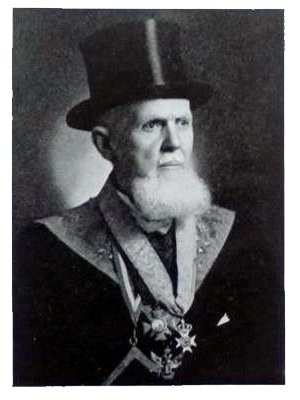 When we study Huiracocha, it becomes clear that he studied the German Esoteric & Occult authors of his time, including: Kummer, Kurtzahn, and Peryt Shou (he seems to have also been friends with the last two).
When we study Huiracocha, it becomes clear that he studied the German Esoteric & Occult authors of his time, including: Kummer, Kurtzahn, and Peryt Shou (he seems to have also been friends with the last two).
And, if we read those German authors, then we can see that they read and/or were influenced by Gorsleben, Marby, List and Fischbach. So we have included them in an effort to show the possible sources, inspirations or (at the very least) similarities between authors.
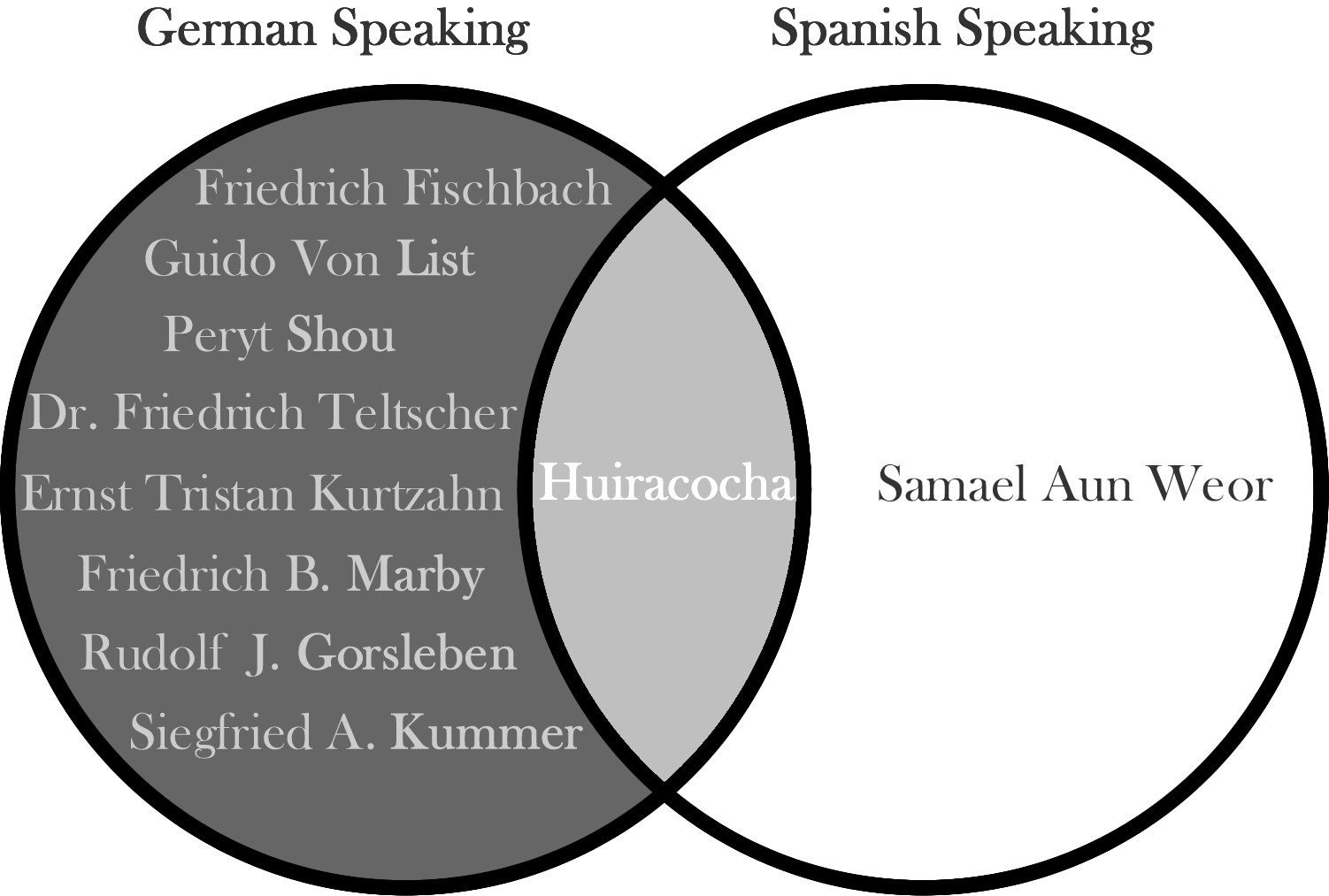
The Runes we will be Studying
The influence of Guido von List on 20th century runic studies can not be underestimated. Although Johannes Bureus used a slightly modified version of the Younger Futhark runic alphabets (combining several variants together) in the 1600s, to which List added a few more, it is clear that List’s alphabet became the popular one among many of those interested in Völkisch studies.
It is sometimes said that Guido von List created a new ‘Alphabet of 18 Runes’ (often referred to as the “Armanen” Runes). However, both Bureus and Fischbach also emphasized the same first 15, calling the remaining ones “more recent” runes. What List attempted to do was to reduce all the different rune alphabets into the most important ones.
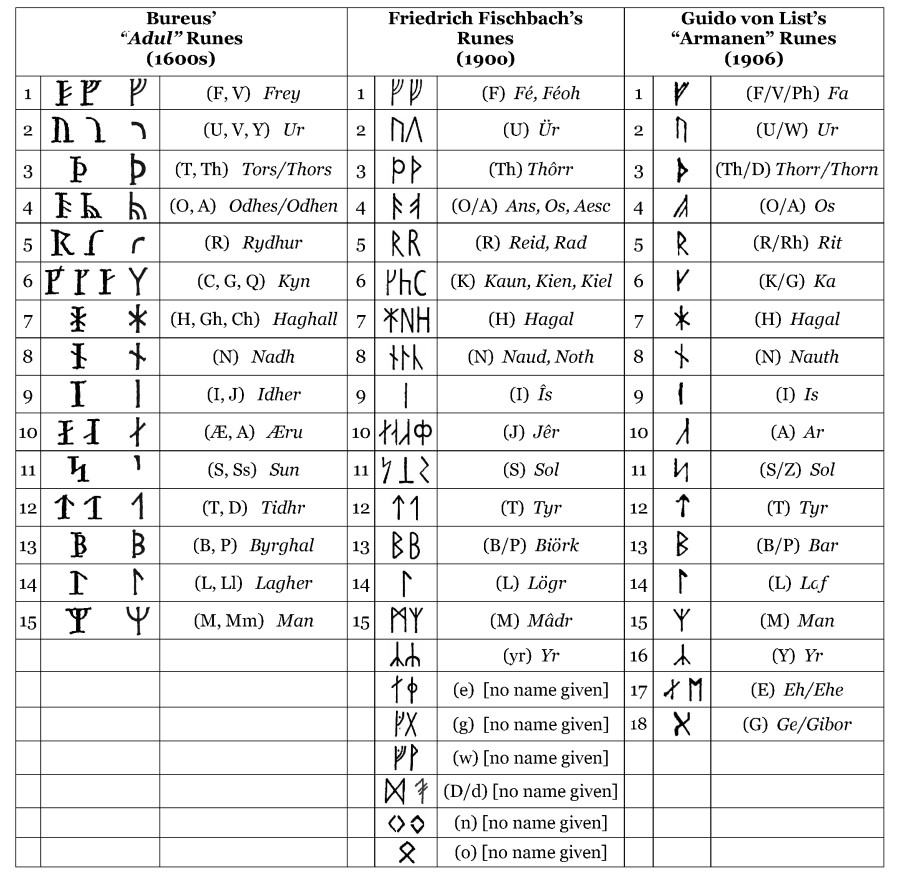
Almost all the rune authors we are studying agree on the first 15. List added 3 more and many rune authors (inspired by him) have adopted the 18 “Armanen” Runes as the primary ones. However, in our study we will look at additional runes (and variants of those primary ones).
Below we have a table listing the runes on the left and, along the top, the names of the authors we are studying who mention them (explicitly as a rune):
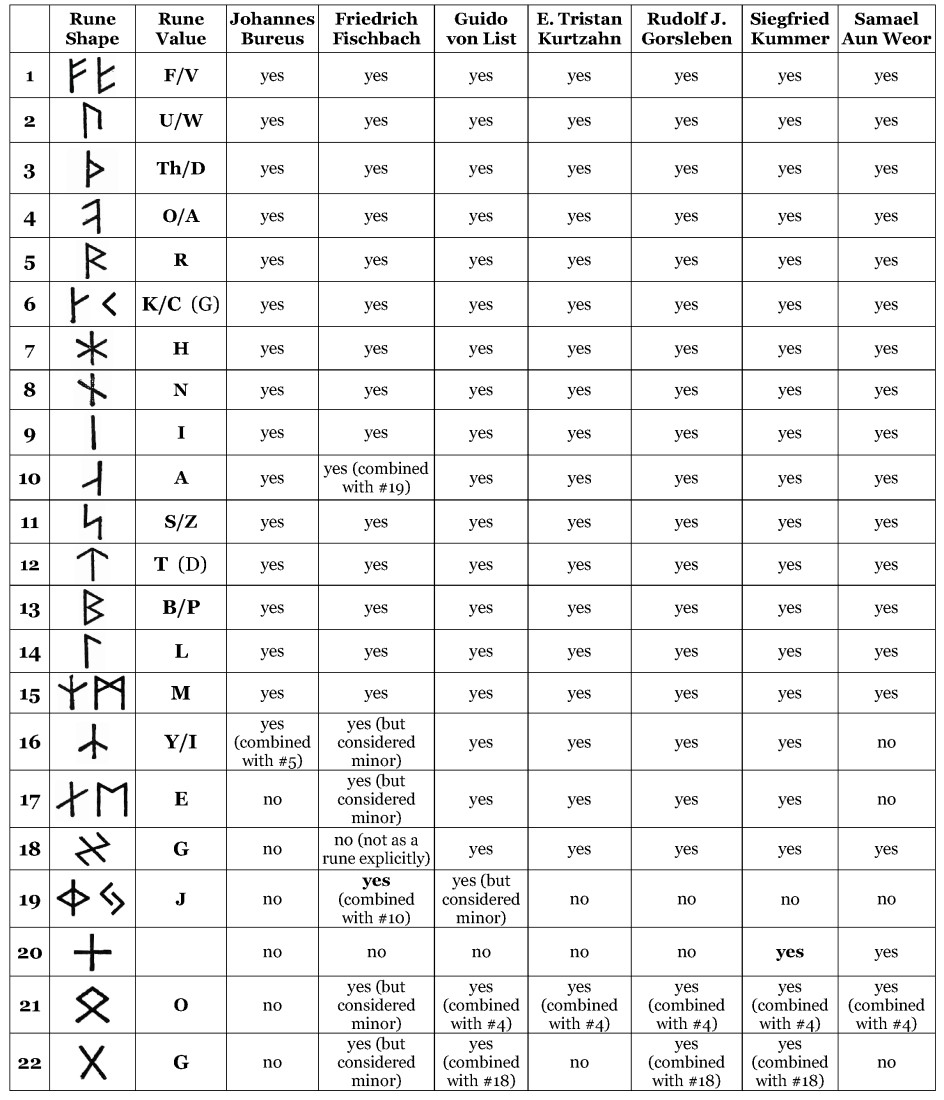
Part 2 – Rune-Songs and Mnemonics for Runic Studies
Runic “Songs” and Alliteration
As we have learned (when we studied the Mythological aspect), singing ‘rune songs’ or the chanting of rune poetry (“enchanting”) plays a role in the folklore of the runes. After Odin had hung nine nights on the World tree, he learned ‘rune songs’ or ‘runic incantations’ before coming down.
Fischbach explains that “the Runes were not Magic-Formula [Zaubermittel ] in and of themselves, because they became magical only through Incantations or Magic-Sayings [Zaubersprüche ]“. He also says that, in order to perform their Healing functions, these Sayings were invoked through a “Healing Song [Lied Heil ]”.
At this point, we should understand the limitations when trying to translate certain German words into English (which we also mentioned when discussing Marby’s Runic Philosophy).
The German word Heil has many different meanings when translated into English:
hail; heal, healing, cure, curative; well-being, welfare; good; salvation, deliverance; intact, unhurt, undamaged, in one piece.
So this word includes not only ‘health/healing’, but is also connected with ‘salvation’, ‘well-being’ and even ‘hail’ (a greeting or praise-giving phrase):
Heil = Hail = Health = Well-Being = Salvation
And the German word Heilige (meaning holy, sacred, saintly, devout, sanctified) comes from the root Heil… This means that the English concepts of ‘health/healing’, ‘holy/sacred’, and ‘salvation’ are all unified in a single word in German.
So when we discuss a “Healing [Heil ] Song”, this song is also a “Salvation Song”, a “Song of Well-Being”, as well as a “Hailing Song”.
Fischbach says that these Songs were “closely connected with the Runes through alliteration” (use of similar phonetic sounds at the beginning of adjoining words).
It was very important that the Rune conformed to the Incantation or Magic-Saying and, Fischbach tells us, the Rhyme repeated the Initial-Sound, “to make the Saying more powerful”. He gives an example with Divination, when the answer was given: it was in rhyme, “the Seer rhymed the alliterated Runes”.
Maybe the most famous alliterative rhyme in English is ‘Peter Piper’:
“Peter Piper picked a peck of pickled peppers.
If Peter Piper picked a peck of pickled peppers,
where’s the peck of pickled peppers Peter Piper picked?”.
The Runic Body-Postures and their “Songs“
Fischbach’s alliteration concept seems to have been picked up by Guido von List, because of the building blocks in List’s Kala Mystery Language. We covered this in more detail in Guido Von List’s Runic Ideas, but we will try to summarize the relevant ideas below.
The Kala , or what List sometimes calls the “aryan Primordial-Language [arische Ursprache ]”, is based on phonetic values (as opposed to numeric values, like in the Kabbalah), where the runes correspond to a combination of Vowel-Sounds (A, E, I, O, U) and/or Consonant-Sounds.
 by Guido von List2.jpg)
These sounds are combined together to make syllables or ‘sound formulas’ which, List says, have an esoteric significance. These combinations form what List calls ‘Seed-Words’ [Keimworte ].
As an example, for the 1st rune ![]() (which has a phonetic value of ‘F’), the Seed-Words are:
(which has a phonetic value of ‘F’), the Seed-Words are:
‘Fa, Fe, Fi, Fo, Fu’ and ‘Af, Ef, If, Of, Uf’.
And, in fact, the Seed-Words for all the Consonant-Runes [Mitlautrunen ] are made by simply adding the five Vowel-Sounds to the corresponding Consonant-Sounds.
 by Guido von List2_OCR_sm.jpg)
If we take the Seed-Words that start with the corresponding Consonant-Sound, then we have a very basic alliterative ‘song’: “Fa, Fe, Fi, Fo, Fu”.
When Kummer publishes his “Holy Runic-Power [Heilige Runenmacht ]” book (in 1932), he gives these same ‘songs’ for his corresponding rune practices. Using the 1st rune ![]() again, one takes up the corresponding posture and he says one should:
again, one takes up the corresponding posture and he says one should: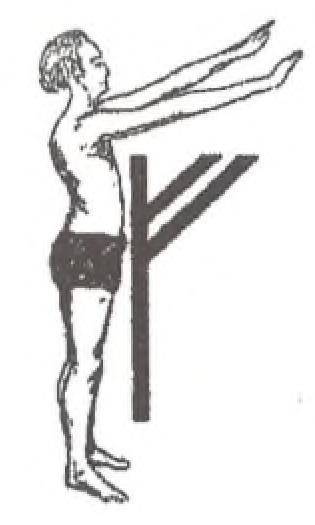
“softly sing or hum the ‘F’ or ‘Fa’.
I recommend the following Sound-Formula [Lautformel ]: ‘fa-fe-fi-fo-fu’ …”
On the other hand, the Vowel-Sounds, generally just keep their own sound (such as ‘U’ for ![]() the 2nd rune) or they use the rune’s name (or a derivation of it) as the Seed-Word (such as ‘Os’ for
the 2nd rune) or they use the rune’s name (or a derivation of it) as the Seed-Word (such as ‘Os’ for ![]() the 4th rune). However, there is also the possibility of combining the Vowel-Sound with the five vowels, such as ‘Aa-Ae-Ai-Ao-Au’ or ‘Aa-Ea-Ia-Oa-Ua’ for
the 4th rune). However, there is also the possibility of combining the Vowel-Sound with the five vowels, such as ‘Aa-Ae-Ai-Ao-Au’ or ‘Aa-Ea-Ia-Oa-Ua’ for ![]() the 10th rune which corresponds to the ‘A’ sound.
the 10th rune which corresponds to the ‘A’ sound.
 by Guido von List2_OCR.jpg)
Below we have a table showing the rune posture and corresponding ‘song’ as “Associated Traditional Germanic Mantram” which have been taken from those given by Kummer (and/or other authors if available):
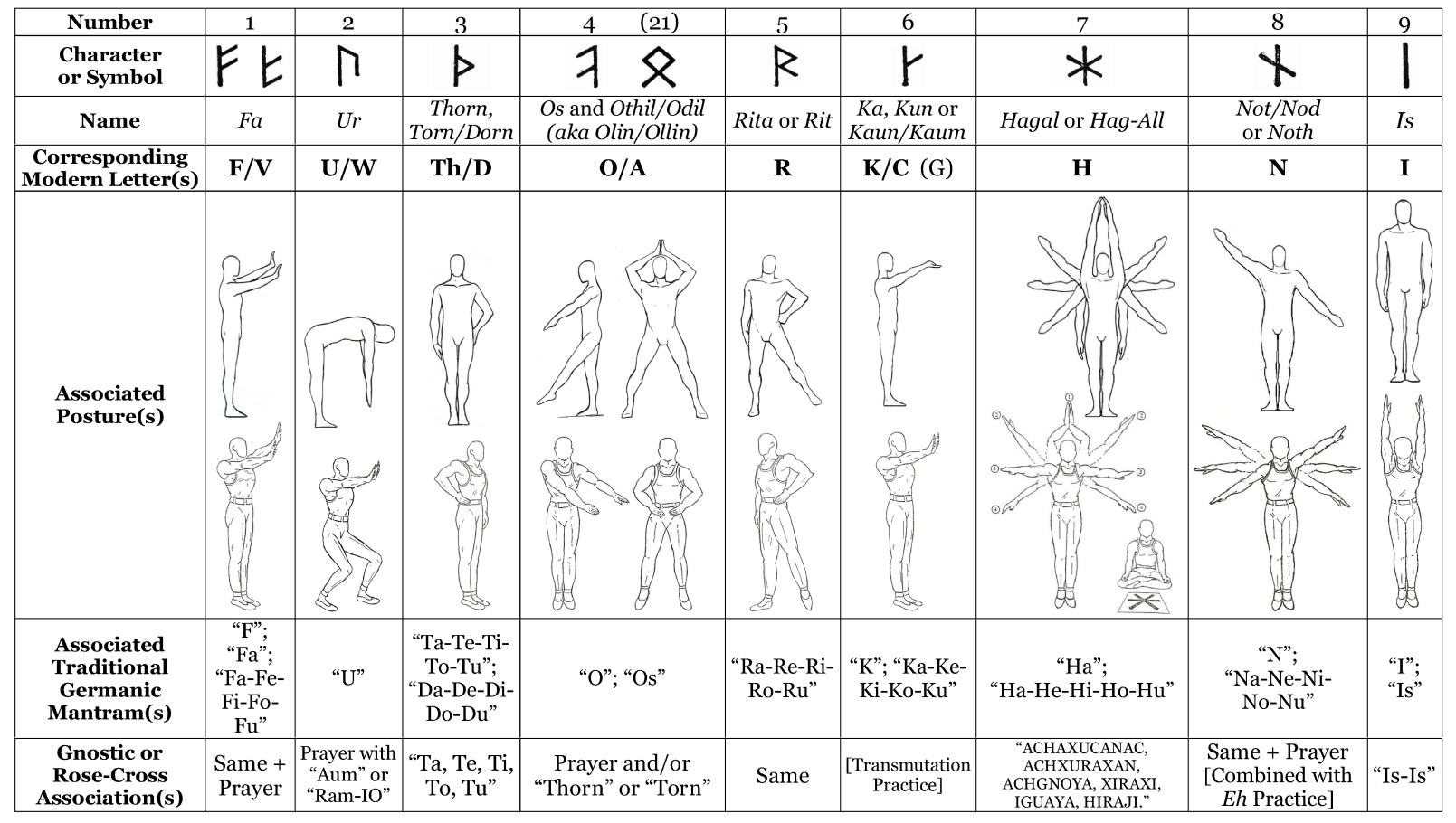
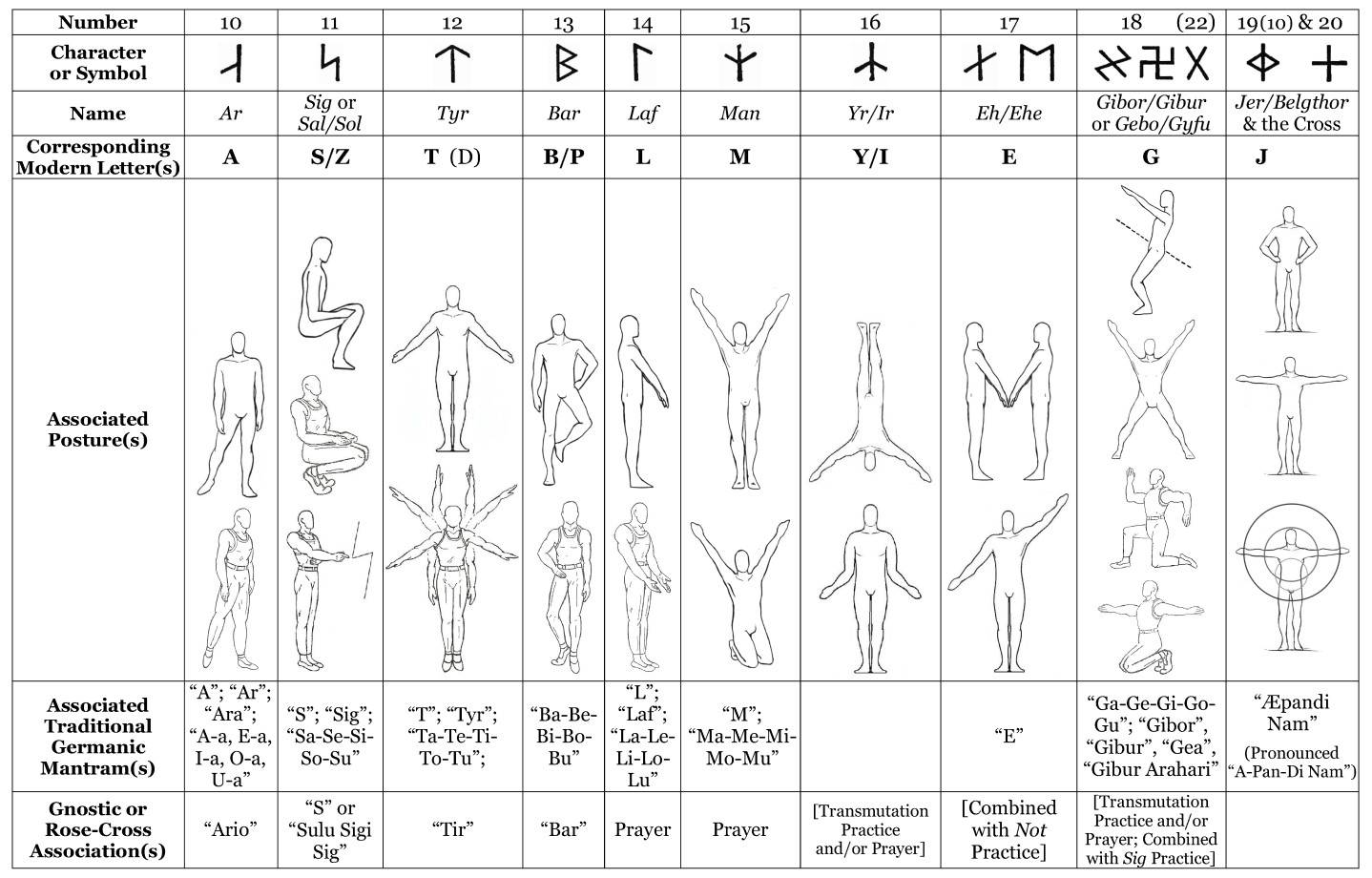
Part 3 – Racial Themes in Runology
The term ‘Aryan’, the Völkisch Movement and the Need to Extract what is Useful
We mentioned that the term ‘Aryan’ was used differently by Blavatsky than it was by Völkisch authors (in Historical Context), and the Gnostic Movement uses it similarly to how Blavatsky used it (referring to the 5th Root Race, that is: all the peoples populating our planet in these present times). Therefore, if we interpret the German author’s use of the term ‘Aryan’ in its Gnostic sense rather than its Völkisch sense, then we get a very interesting perspective. That being said, we need to remember the definite impact that Völkisch ideas had on the previous centuries, and continue to have on people searching for an understanding of identity.
1c.jpg) Often, we think of “Völkisch ” as referring to only those of European ancestry, but the idea of a ‘special’ group (or “Folk”) is often used as a catalyst to unite a people, regardless of their ancestry. We see it not only in “racial-power” movements, but also in: religious extremism, nationalism, and even gang culture.
Often, we think of “Völkisch ” as referring to only those of European ancestry, but the idea of a ‘special’ group (or “Folk”) is often used as a catalyst to unite a people, regardless of their ancestry. We see it not only in “racial-power” movements, but also in: religious extremism, nationalism, and even gang culture.
Many times people want to define themselves by what group or groups they belong to (or by which ones they don’t belong to), but, in terms of Gnostic Psychology, this does not really allow us to know ourselves.
To know ourselves, to know what we are internally, depends firstly on our ability to direct our attention to our interior. Secondly, it depends on what we do with the data we receive from our observations.
If we define ourselves based on exterior things (“race”, ethnicity, nation, politics, socio-economic situation, local affiliation, etc.), then we are more trying to fit a predefined mold of what that exterior thing ‘should’ be, rather than we are trying to study ourselves. So if our goal is to know ourselves, then let us recognize the drawbacks of group affiliation(s) and, instead, let us attentively study ourselves.
In any case, in our study of the Runes, we must note the influences that have affected Modern Runology, so that we can understand what needs to be discarded and what needs to be emphasized. Modern Runology emerged from a Völkisch culture, and we can study this while (at the same time) extracting the essential concepts from it in order to “salvage” some wisdom from these authors.
Let us not forget that after WWII, the United States took many German scientists who had been working in missile & rocket technology and used them to put a man on the moon (see Operation Paperclip). So let us also take advantage of this esoteric information, but without becoming fanatical, because there are some themes here that can help us advance quickly in these studies.
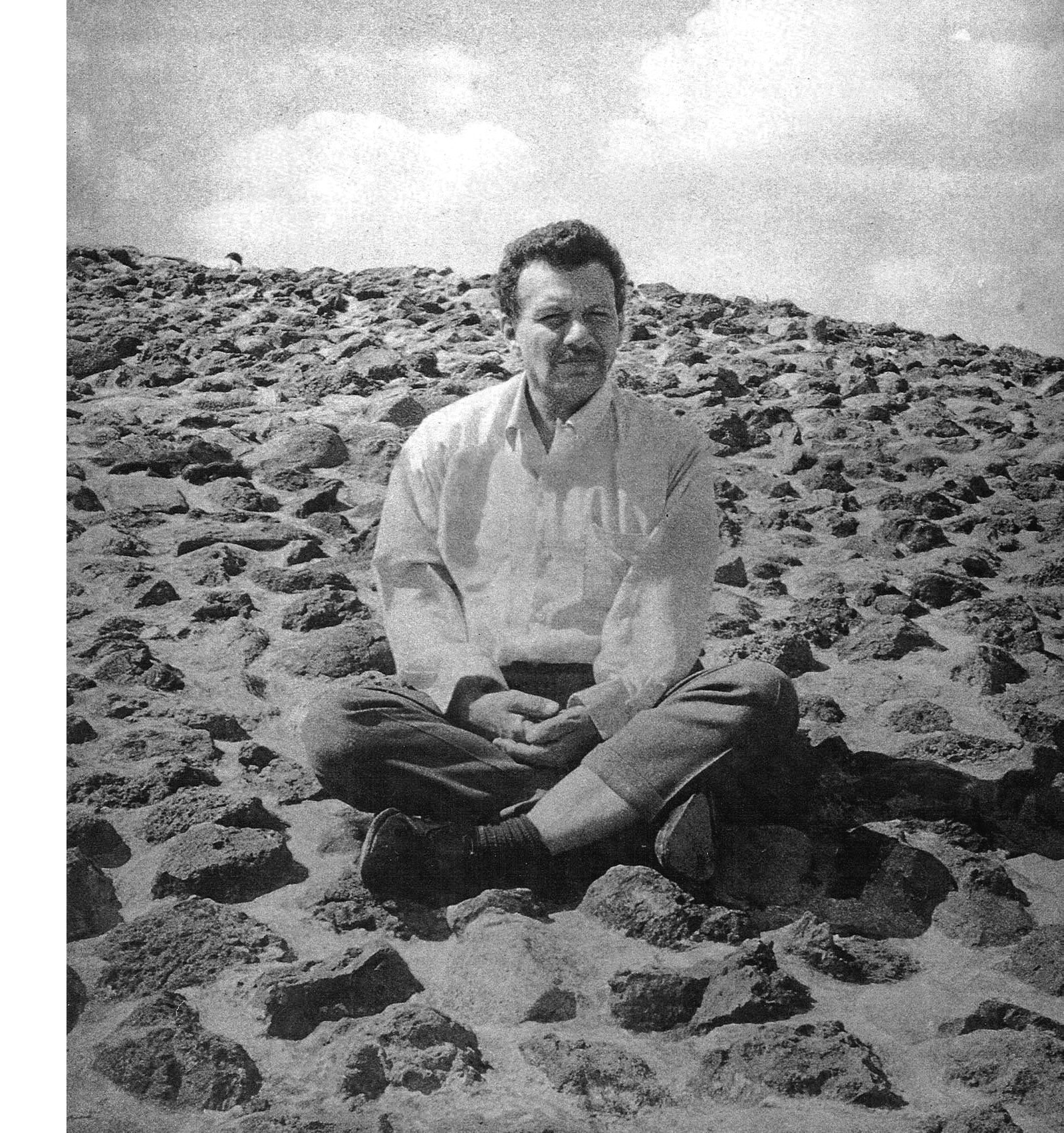 A Note about Race: The Gnostic Movement’s Position
A Note about Race: The Gnostic Movement’s Position
The following is from Igneous Rose (first published in 1954) by Samael Aun Weor:
“In his Course of Runic Magic, the Master HUIRACOCHA teaches all these things [referring to certain Runic Exercises]; however, the sacred Runes are not the property of Master HUIRACOCHA, because this knowledge is as ancient as the world and belongs to the great Schools of Internal Mysteries.
We do not accept the statement of the Master Huiracocha which states that black and yellow skinned people cannot belong to the WHITE LODGE because it is only for people who belong to the white race. We cannot accept this type of racial prejudice, because the WHITE LODGE is universal. Masters from all races exist within our venerable WHITE LODGE. We must not forget that the Masters MORIA and K-H (Kout Humi) belong to the yellow race. The white race is not superior nor inferior than another race; simply, it is different, that is all…
We also disagree with Master Huiracocha’s despise for Oriental wisdom. Christ taught three ways in order to reach the union with the Intimate (the INTIMUS or Inner Being).
[1] When he was preaching to the multitudes, when he was mystically exalted, he showed us the way of Ramakrishna, Kempis, and Francis of Assisi. This is the path of Anthony of Padua and Theresa of Jesus. This is the Mystical Path.
[2] When Christ was walking with Magdalene, the repented prostitute, when he was among publicans and sinners, fishermen and wine drinkers, he showed us the Gnostic path.
[3] When he retired to the solitude of the desert for forty days and forty nights, he then taught the way of oriental Yoga.The seven rays of cosmic evolution are synthesized in these three ways that the Nazarene showed. Therefore, we cannot despise Oriental wisdom.
All human Intimates (or Inner Beings) who are fastened to the wheel of births and deaths belong to these three ways. With all this, we sustain that sexual magic between husband and wife is the way in order to reach Nirvana. Therefore, we cannot accept the racial prejudice of Master Huiracocha for any reason. God has no preference for anyone. All human beings without distinction of sex, race, creed or color are beloved children of the FATHER and have the same rights.
We also cannot accept the absurd thesis of Huiracocha, who stated that it is a sin for a man of one race to become married with a woman of another race, and that the bastard children of such marriages are children of the devil.
We recognize that the Master Huiracocha is a GURU of the Universal White Fraternity and it is evident for me that he is an Archbishop of the Gnostic Church; yet, he committed a lamentable mistake when he made these statements in his Course of Runic-Magic. There is no doubt that if the Guru Huiracocha had a physical body he would rectify those errors, because humans commit errors, however, only those who are stubborn remain in the error.
…All human beings, white, black, yellow, red and brown, have the right to speak the Verb of Light and to form part of the Great Universal White Fraternity, because everyone is a beloved child of the Father. God has no preference for anyone, he cares equally for humans and ants, birds and reptiles.
God has no racial prejudice and loves all his children with infinite love, without distinction of sex, race, creed or color. We must love all human beings; we must give even the last drop of our blood for all our brothers and sisters who belong to this great human family.
Evil ones criticize me because I teach the secret doctrine of the Gnostics to humanity. I diffuse all the esoteric teachings in order to save all my brothers and sisters of this humanity. Everything that I know is for my brothers and sisters. Therefore, I have decided to teach them the most sacred things of the universe, so that they may enter Eden, as I have entered.”
-Paraphrase from Ch. 31 of Igneous Rose [Rosa Ignea] (1954)
by Samael Aun Weor
Download the Handouts for this class:
– = Read the NEXT PART = –